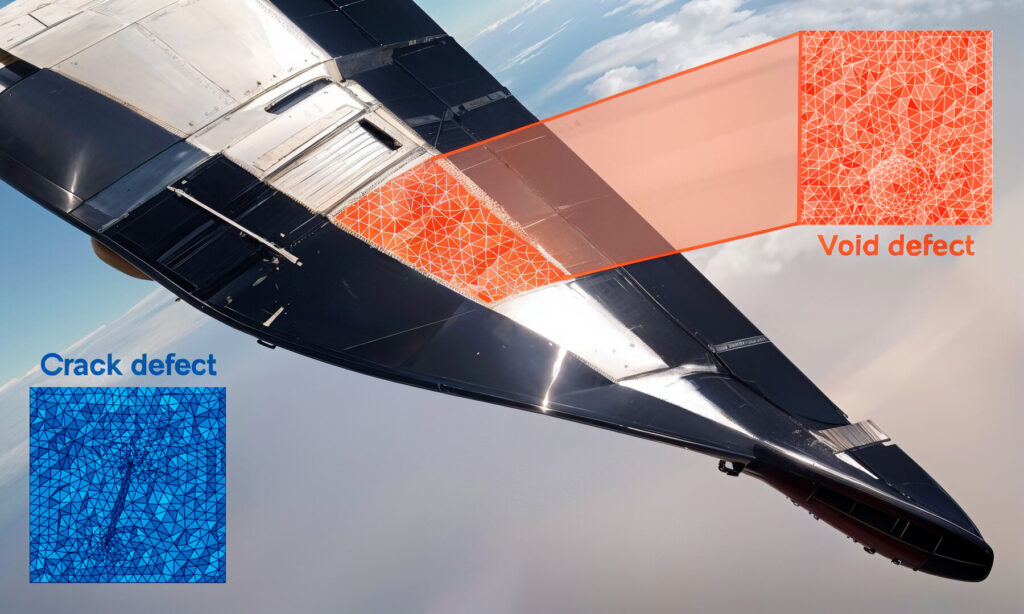Skoltech researchers have created a digital twin of a polymer composite material with a 2D sensor and successfully used it for structural integrity testing. The new technology can be used to manufacture various large structures, such as aircraft wings, wind turbine blades, and bridge spans, which are currently made of polymer composites.
The layer of carbon nanotubes that the team inserted between the fiber-reinforced layers of the composite is so thin that adding a 2D sensor does not affect the thickness or overall design of an aircraft skin or other part.
Defects in aircraft parts can be detected based on the changes in the electrical conductivity of the layer, and measurements can even be made during flight. This approach, called electrical impedance tomography, is a more efficient and less expensive alternative to fiber-optic sensors.
Two papers describing the results of the digital twin tests came out in Composite Structures and International Journal of Engineering Sciences.
Early detection of defects in a polymer composite part, such as an aircraft wing or the bottom of a yacht, is ensured by embedded fiber optic sensors. A change in the sensor’s signal indicates cracking or delamination—the most common failures in polymer composites.
Fiber-optic sensors have several drawbacks. First, the signal processing equipment is expensive. Second, these one-dimensional sensors can only detect defects along the fiber path. Third, fiber optic sensors tend to affect the strength of the material.
“A polymer composite consists of several layers of carbon or glass fibers impregnated with epoxy resin and sintered together. Their diameter is 5–10 microns, compared to 50–150 microns for optical fibers. To put this in perspective, increase these dimensions 1,000-fold and you will get a stack of pencils glued together, with something as large as a two-liter bottle of soda squeezed inside,” says Sergey Abaimov, the study’s principal investigator and a leading research scientist at Skoltech Petroleum.
“Integrating this sensor without compromising the strength of the material and causing strain concentrations is a daunting task. In this example, a nanotube several tens of nanometers thick would be comparable to a thread that can be neatly concealed in a pencil box.”
Previously, Abaimov’s team had proposed an alternative to optical fibers by replacing one of the fiber layers in the composite with a layer of electrically conductive carbon nanotubes, which can act as a sensor to monitor the integrity of the part.
In an earlier study, the researchers fabricated and strength-tested a sample of a modified composite and found that the nanotubes not only did not degrade the material’s properties, but actually improved them.
In their new study, the researchers tested the digital twin and found that a change in the electrical signal in a layer of nanotubes can help find defects in the composite. Such a 2D sensor has a much wider coverage than a 1D optical fiber, but deciphering its signal is a task in itself, which the team addressed by placing electrodes (in the model) along the sensor’s perimeter in order to measure the electrical potential.
With more than two electrodes, the sensor becomes two-dimensional, eliminating the second drawback of fiber optics: regardless of its location, a defect always falls within the sensor’s range. In addition, the signal processing equipment for electrical tomography is much less expensive than that for optical signals.
Discover the latest in science, tech, and space with over 100,000 subscribers who rely on Phys.org for daily insights.
Sign up for our free newsletter and get updates on breakthroughs,
innovations, and research that matter—daily or weekly.
A standard-issue electrical resistance multimeter is employed, it’s just that the multichannel model has to be used to accommodate many electrodes.
“Extracting fracture data from the multichannel electrode signal was the biggest challenge which we successfully overcame by training machine learning algorithms to detect defects. We used the voltage readings from the electrodes as input vectors in the machine learning model and directly predicted the spatial distribution of the defect using a voxel-based representation of the nanocomposite,” explains Iskander Akmanov, the lead author of the two new papers on the integrity monitoring technology and a Petroleum Engineering Ph.D. student at Skoltech.
The researchers were successful in their efforts to ensure that machine learning would not only detect fracture defects, but also their locations, sizes, and shapes.
The team plans to test the new algorithms on a real object, such as a part of an aircraft wing, and implement the technology in the aircraft industry.


